
Orion Crew Module PA-1 Departs
|
Boilerplate Orion Crew Module PA-1 was loaded aboard an Air Force Boeing C-17A Globemaster III at the NASA Dryden Flight Research Center on August 18, 2009. It will be flown to Holloman Air Force Base and then trucked to the White Sands Missile Range for the first Launch Abort System (LAS) Pad Abort Test.
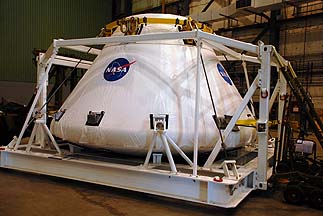 Boilerplate Orion Crew Module PA-1 is the same basic shape as the Apollo Command Module but 60% larger. It was built by NASA at the Langley Research Center. It is not a fully fundctional Crew Module. It has some of the electronic systems for integration and acoustic load testing. It was subjected to 100 decibel noise to determine the impact of the acoustic energy that would be applied to it by the rocket engines of the Launch Abort System (LAS). It weighs 17,000 pounds. Fully integrated it will weigh 18,000 pounds. The Launch Abort system will add another 12,000 pounds gfor a total of 30,000 pounds. The 500,000-pound thrust of the LAS will lift the Crew Module with an acceleration of 15 Gs to an altitude of about 1 mile.
Boilerplate Orion Crew Module PA-1 is the same basic shape as the Apollo Command Module but 60% larger. It was built by NASA at the Langley Research Center. It is not a fully fundctional Crew Module. It has some of the electronic systems for integration and acoustic load testing. It was subjected to 100 decibel noise to determine the impact of the acoustic energy that would be applied to it by the rocket engines of the Launch Abort System (LAS). It weighs 17,000 pounds. Fully integrated it will weigh 18,000 pounds. The Launch Abort system will add another 12,000 pounds gfor a total of 30,000 pounds. The 500,000-pound thrust of the LAS will lift the Crew Module with an acceleration of 15 Gs to an altitude of about 1 mile.
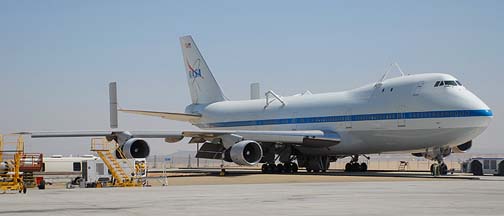 NASA Boeing 747 Shuttle Carrier N905NA sat on the flightline nearby.
NASA Boeing 747 Shuttle Carrier N905NA sat on the flightline nearby.
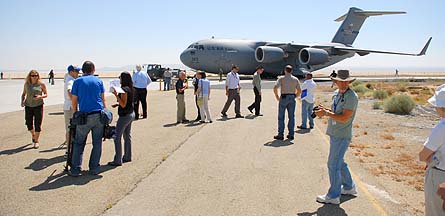 NASA personnel and media representatives watched as Air National Guard Boeing C-17A Globemaster III 03-3113 from the 172nd Airlift Wing based at Jackson, Mississippi was towed to its parking spot.
NASA personnel and media representatives watched as Air National Guard Boeing C-17A Globemaster III 03-3113 from the 172nd Airlift Wing based at Jackson, Mississippi was towed to its parking spot.
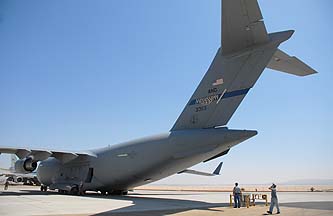 Videographers from the Johnson Space Center covered every movement.
Videographers from the Johnson Space Center covered every movement.
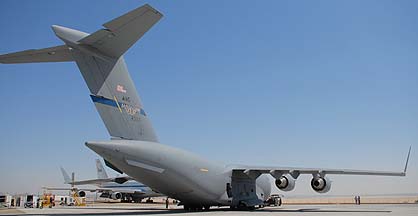 C-17A Globemaster III 03-3113 was backed into position.
C-17A Globemaster III 03-3113 was backed into position.
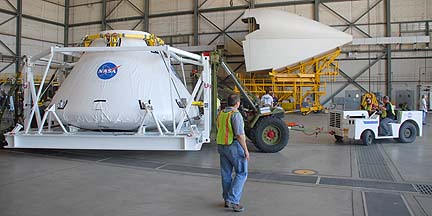 Orion Crew Module PA-1 was secured on a shipping frame and wrapped in a protective cover. It will be used for the Pad Abort I Mission, currently scheduled for January 2010. The aerodynamic tail cone of the space shuttle sat on its installaion rig in the same hangar.
Orion Crew Module PA-1 was secured on a shipping frame and wrapped in a protective cover. It will be used for the Pad Abort I Mission, currently scheduled for January 2010. The aerodynamic tail cone of the space shuttle sat on its installaion rig in the same hangar.
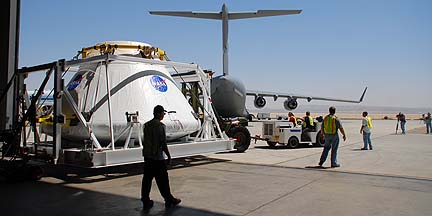 Several observers carefully oversaw the movements of Crew Module as it was towed out into the sunlight.
Several observers carefully oversaw the movements of Crew Module as it was towed out into the sunlight.
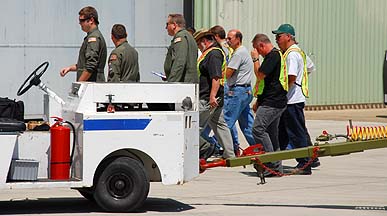 Once the Crew Module was in position, NASA personnel and the crew of the C-17 moved inside to confer about loading it into the cargo bay.
Once the Crew Module was in position, NASA personnel and the crew of the C-17 moved inside to confer about loading it into the cargo bay.
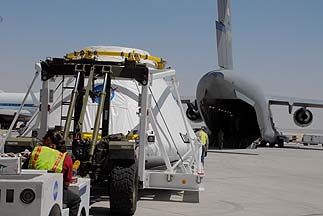 The loading procedure requires a few hours to carefully move the Crew Module into position inside the payload bay.
The loading procedure requires a few hours to carefully move the Crew Module into position inside the payload bay.
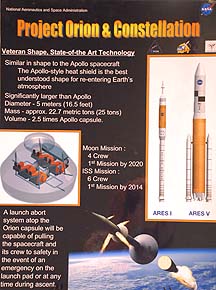 The Orion Crew Module is currently expected to be launched by the Aries 1 booster beginning in 2015. The first stage of Aries I is derived from the Space Shuttle External Booster.
The Orion Crew Module is currently expected to be launched by the Aries 1 booster beginning in 2015. The first stage of Aries I is derived from the Space Shuttle External Booster.
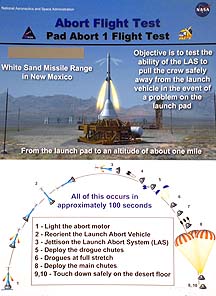 The objective of Pad Abort 1 test is to test the ability of the LAS to pull the crew safely away from th launch vehicle in the vent of a problem on the launch pad. It will last just 100 seconds from launch to landing. The crew module will be lifted to an altitude of about 1 mile and land under three parachutes about 1 mile downrange. It will touch down with a vertical velocity of about 20 miles per hour.
The objective of Pad Abort 1 test is to test the ability of the LAS to pull the crew safely away from th launch vehicle in the vent of a problem on the launch pad. It will last just 100 seconds from launch to landing. The crew module will be lifted to an altitude of about 1 mile and land under three parachutes about 1 mile downrange. It will touch down with a vertical velocity of about 20 miles per hour.
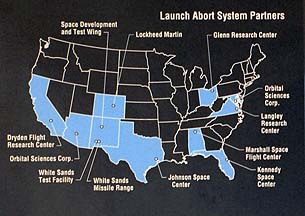 Partners in the Launch Abort System are located across the country.
Partners in the Launch Abort System are located across the country.
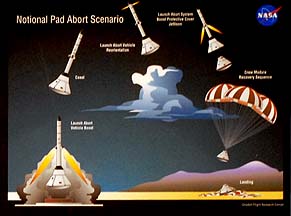 The Notional Pad Abort Scenario includes the following steps:
The Notional Pad Abort Scenario includes the following steps:
Launch abort vehicle boost
Coast
Launch abort vehicle reorientation
Launch abort system boost protective cover jettison
Crew module recovery sequence
landing
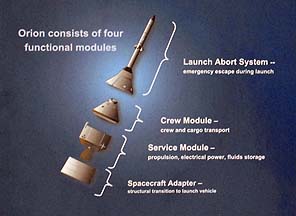 The Orion consists of four functional mdules:
The Orion consists of four functional mdules:
Launch Abort System
Crew Module
Service Module
Spacecraft Adapter
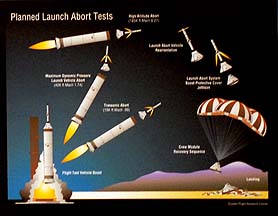 There are five abort tests planned:
There are five abort tests planned:
Pad Abort 1
Ascent Abort 1 will take place as the Flight Test Vehicle (FTV) experiences maximum dynamic pressure at a speed of Mach 1.74 and an altitude of 40,000 feet. It is scheduled for December 2011.
Ascent Abort 2 will take place as the FTV reaches the speed of sound at an altitude of 19,000 feet. It is scheduled for 2012.
Pad Abort 2 will use a crew module that is closer to the production version. It is scheduled for 2013.
Ascent Abort 3 will take place at high altitude, 185,000 feet and a speed of Mach 6.27.
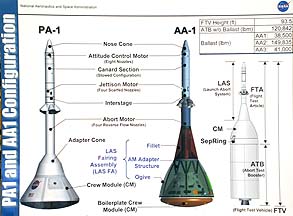 The design of the Crew Module has evolved since PA-1 was designed. Subsequent crew modules will be built by Lockheed-Martin. A fairing with an ogive shape will enclose the crew module to protect it from the aerodynamic loads of launching and possible abort. The Flight Test Vehicle booster is derived from the first stage of the Peacekeeper Missile.
The design of the Crew Module has evolved since PA-1 was designed. Subsequent crew modules will be built by Lockheed-Martin. A fairing with an ogive shape will enclose the crew module to protect it from the aerodynamic loads of launching and possible abort. The Flight Test Vehicle booster is derived from the first stage of the Peacekeeper Missile.
 Send a message to Brian.
Send a message to Brian.